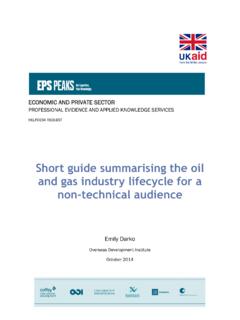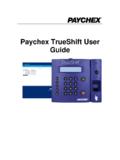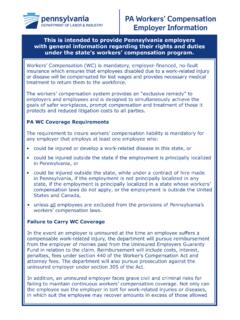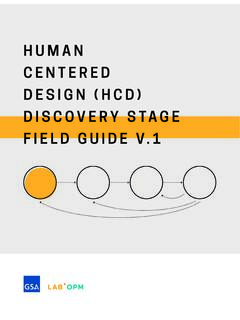Transcription of Handling and housing cattle AIS35 - HSE
1 1 of 5 pagesHealth and Safety ExecutiveHealth and Safety ExecutiveAgriculture Information Sheet No 35 (Revision 1)HSE information sheetHandling and housing cattleIntroduction This information sheet provides general advice for farmers on safe Handling of adult cattle , including stock bulls, bull beef, suckler and dairy cattle , and on housing stock bulls and bull beef safely. It also gives advice on preparing cattle for slaughter. It does not include the precautions necessary to protect the public when keeping cattle in fields with public access, which the Agriculture Information Sheet AIS17 Keeping cattle in fields with public access covers. Every year there are deaths and injuries to farmers and other workers while Handling cattle .
2 These are often caused by using poor equipment, ineffective methods of moving cattle and an underestimation of the strength, speed or behaviour of risks Handling cattle always involves a risk of injury from crushing, kicking, butting or goring. The risk is increased if the work involves animals that have not been handled frequently, such as those from hills or moorland, sucklers or newly calved cattle . Certain jobs, such as veterinary work, may increase the risk further. However, proper Handling systems, trained and competent staff, and a rigorous culling policy can help make sure cattle Handling can be carried out in relative safety. You should never underestimate the risk from cattle , even with good precautions in place.
3 Familiarity with individual cattle can lead to complacency, especially when Handling bulls. A number of accidents, some fatal, happen every year because stockpeople fail to treat bulls with respect. A playful bull can kill you just as easily as an angry one. General principles of cattle Handling You need to consider the following: the person including their mental and physical abilities, training and experience; the equipment available including races, crushes, loading facilities and bull- Handling equipment; andthe animal including its health and familiarity with being handled. The person Everyone Handling cattle should be: able to use the Handling and other safety equipment provided; aware of the dangers when Handling cattle and be supervised until they are competent; able to work calmly with the cattle , with a minimum of shouting, impatience or unnecessary force; andin good health and properly trained in safe work methods.
4 Training in livestock Handling is available from training groups, colleges and individual training providers. Some work with cattle will need two people. Always assess the need for help before beginning the task. There is no legal upper or lower age limit for cattle Handling , as individuals capabilities vary widely, but children under 13 should not normally be allowed to enter cattle housing or handle cattle . Many incidents involving cattle happen to people beyond normal retirement age, when they are less agile. Consider the risks carefully before anyone over 65 works with cattle , and if so, what they can safely do. The equipment Every farm that handles cattle should have proper Handling facilities. These should be well-maintained and in good working order.
5 A race and a crush suitable for the animals to be handled are essential. Makeshift gates and hurdles are not sufficient, and will result in less efficient Handling as well as risking injury. Never attempt to treat or work on any animal that is held by gates alone, or that is otherwise free to move at will. If you have to attend to downer cattle , or animals in loose boxes or isolation pens, and it is not possible to secure them, make sure you have an adequate escape route and will not be crushed if the animal rolls or stands suddenly. Special equipment is needed for Handling stock bulls out of the pen. 2 of 5 pagesHealth and Safety ExecutiveThe race Check that: animals can readily enter the race, which should have a funnel end, and there is enough room in the collecting pen for them to feed into the funnel easily.
6 A circular collecting pen allows staff to stand safely behind a forcing gate as they move animals into the race, and keeps the animals moving;animals can see clearly to the crush and beyond, so they will readily move along the race, which may be curved, but should not include tight turns. Animals will be more prepared to move towards a light area than into the dark; the sides of the race are high enough to prevent animals from jumping over them, and they are properly secured to the ground and to each other sheeting the sides of the race helps to keep cattle moving by reducing visual disturbances such as shadows and shields them from other animals; andyou can contain the lead animal in the race while it waits its turn in the crush.
7 Hinged or sliding doors are suitable, but be sure they are operated from the working side of the race so the operator does not have to reach across it to close the gate. No one should work on an animal in the crush with an unsecured animal waiting in the race behind. The crush A crush which will allow most straightforward tasks to be carried out in safety (including oral treatments and work from the rear end, but not belly or foot trimming) will: have a locking front gate and yoke (ideally self- locking) to allow the animal s head to be firmly held. Additional head bars will prevent the animal tossing its head up and injuring people; have a rump rail, chain or bar to minimise forward and backward movement of the animal.
8 Make sure this is always used; be secured to the ground or, if mobile, to a vehicle; be positioned to allow you to work safely around it, without the risk of contact with other animals, and have good natural or artificial lighting; allow gates etc to open smoothly with the minimum of effort and noise. Regular maintenance will help; andhave a slip-resistant floor, made of sound hardwood bolted into place (nails are not suitable), metal chequer-plate, or with a rubber mat over the base. Consider the need for shedder gates after the crush to allow animals to be sorted into groups. Work around the crush will be more convenient if it is under cover with a workbench nearby (for documentation, veterinary medicines, instruments etc).
9 Belly clippingWhile some abattoirs offer a post-slaughter clipping service, cattle are usually required to be presented to an abattoir in a clean condition. Research has shown that the dirtier the hide, the greater the potential for carcase contamination with bacteria such as E coli O157. To achieve the standards needed, farmers may need to:change their cattle production practices to keep cattle clean and reduce the need for clipping;improve housing and transport arrangements; clip the lower parts of the animals before sending them to the Food Standards Agency has produced advice on husbandry systems farmers can adopt to keep animals clean, Clean beef cattle for slaughter: A guide for producers (see Further reading ).
10 The husbandry aspects discussed include; finishing cattle at grass, diet, housing , the general health of cattle and the use of a marketing yard. Putting these systems in place will reduce the need to clean cattle before they leave the farm. Even with good husbandry practices it may be necessary from time-to-time to clip parts of your cattle before presenting them for slaughter. If you do, you will need to take precautions to help control the risk of main hazards are from crushing when you move the animal from the pen to the crush and kicking when you access the underside of the animal to clip it. Clipping should only be carried out using properly designed Handling equipment and safe working techniques. It is therefore essential that you assess the suitability of your cattle Handling facilities and whether you need to modify their design, and to working methods or tools.

















